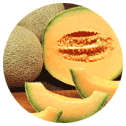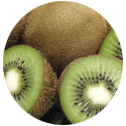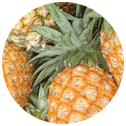 Full List of Fruits
Full List of Fruits  Wild Mangosteen
Wild MangosteenWild Mangosteen
![]() Introduction of Wild Mangosteen
Introduction of Wild Mangosteen
Scientific name - Garcinia indica
Garcinia indica commonly known as wild mangosteen has its roots in the Clusiaceae family, they are also known as kokum. This fruit bearing tree has several gastronomic, pharmaceutical, and industrial uses. In order to get aamsul or kokam, the outer layer of the fruit is dried in the sun. The kokum concentrate is used in preparing a drink called (sherbet) which is bright red in color. It acts as a cooling agent and is best consumed during the summer season and helps improve digestion. Having deep-green lustrous leaves that are just about 5.5-8 cm long and 2.5-3 cm broad, the tree is quite large and is somewhat elliptic, oblong or oblong-lanceolate in shape. With spreading bunches, the flowers are fleshy, dark pink, however sometimes they are solitary.
Marbled with yellow, the fruit is crowned by the 4-parted, stalk less stigma and are brownish or brownish-gray in color. It is about the size of an orange and has 6-8 seeds. Delicious to taste, it contains juicy pulp that's white in color. At its young stage, they are green in color and turns into beautiful purple color when ripe. When the fruit ripens, they are plucked. The tree is a great source of kokam butter which is commonly used in the cosmetics and confectionary industry. During the summer season, an average kokum tree bears out hundreds of fruits.
![]() Nutritional Value of Wild Mangosteen
Nutritional Value of Wild Mangosteen
| Nutrition Facts | |
| Servings Per Recipe: 50 | |
| Serving Size: 1 serving | |
| Amount Per Serving | |
| Calories | 112.3 |
| Total Fat | 0.1 g |
| Sodium | 93.4 mg |
| Potassium | 4.8 mg |
| Total Carbohydrate | 28.7 g |
| Dietary Fiber | 0.4 g |
| Sugars | 25.0 g |
| Vitamin A | 0.1 % |
| Calcium | 0.3 % |
| Iron | 0.9 % |
| Magnesium | 0.2 % |
| Niacin | 0.1 % |
| Phosphorus | 0.1 % |
| Selenium | 0.2 % |
| Zinc | 0.1 % |
Wild mangosteen has been used for medicinal purposes for centuries in Southeast Asia. The rind of the fruit is believed to have anti-inflammatory, anti-bacterial, and anti-fungal properties. It is also said to be beneficial for skin health and may even help reduce the appearance of wrinkles and age spots.
In addition to its health benefits, wild mangosteen is also known for its flavor. The sweet, tangy taste and creamy texture make it a popular addition to desserts, salads, and sauces. It can even be used to make jams and jellies.
The vitamins and minerals found in wild mangosteen also make it a great way to get your daily dose of essential nutrients. It is high in vitamin C, which can help boost immunity, as well as potassium and magnesium, which can help regulate blood pressure.
Wild mangosteen is an excellent addition to any diet. It is full of essential vitamins and minerals, and its unique flavor and health benefits make it a great choice for those looking to add something new and nutritious to their meals.
Containing 23-26% oil, the seeds of Garcinia remain solid at room temperature and they are highly functional in the preparation of confectionery, medicines and cosmetics. With a solid canopy, the tree is ornamental and it has attractive green leaves and red-tinged, tender, young leaves. Extracted oil is called Kokum tel which is used in foot massage.
![]() Health Benefits of Wild Mangosteen
Health Benefits of Wild Mangosteen
The fruits of Garcinia are rich in anti-oxidants and binds well with free radicals which in turn help prevent oxidative damage to body cells. In addition, it also promotes cell regeneration and repair. Known for its other properties that bring down fever and allergic reactions, in the pharmaceutical and cosmetic industry, the kokum butter works wonder on dry, chapped, sensitive, irritated or burnt skin.
As a traditional therapy, the Garcinia fruit is traditionally used to relieve gastric problems like acidity, flatulence, constipation and digestive disorders. Infusions of Garcinia indica is used to treat piles, dysentery and other related infections. On the other hand, they are also know to relieve and fortify the cardio-vascular system and stabilize liver function. Furthermore, hydroxycitric acid in the fruit fights cholesterol and curtails lipogenesis, thereby helping in weight loss.
Propagated on a large scale by seeds, kokum takes up a different strategy to be propagated. Nevertheless, due to its dioecious nature, on 50 per cent seedlings turn out to be males, only female trees produce fruits. They are a very slow grower and it takes about 7 to 8 years for the first flowering to take roots. No specific method is available to spot out the sex of plant in seedling stage and consequently after retaining about 10% male plants, rest have to be gathered or converted into female tree with the action of side grafting. In order to have raising seedlings, fruits are collected from early maturing, heavy yielding plants having bold size fruits. When the seeds are done with the extraction process, they are washed thoroughly in water and dried for 3 to 4 days, later they are sown in small polythene bags (5.0 x 7.0 cm) about 2 cm depth. For early on germination, seeds may be soaked in water for about 2 days. It takes 12-15 days for the seeds to germinate and these seedlings are fostered for one year before planting in the field.


















